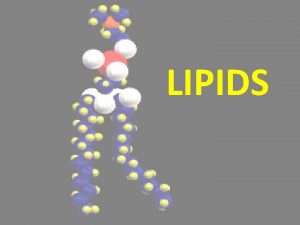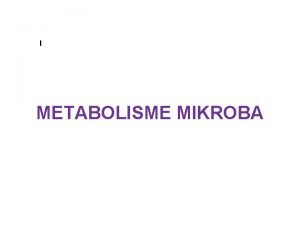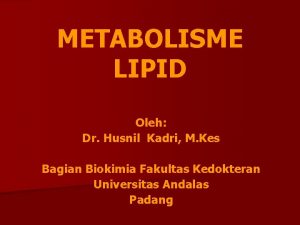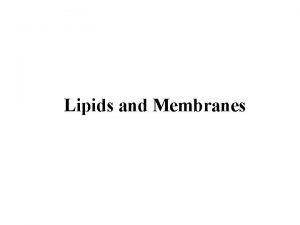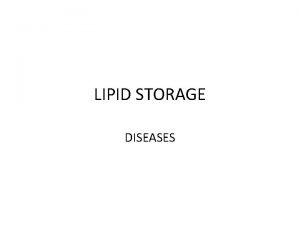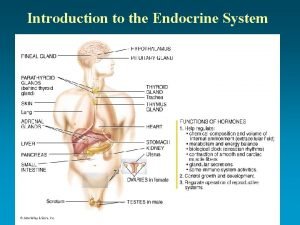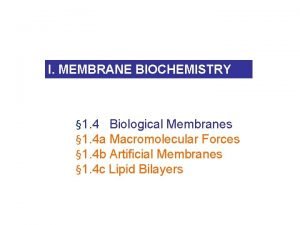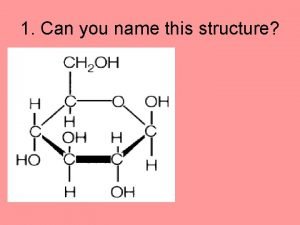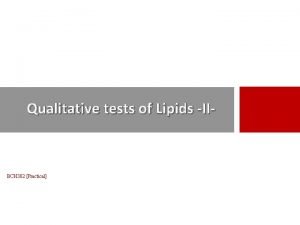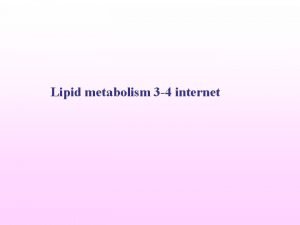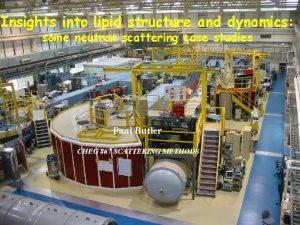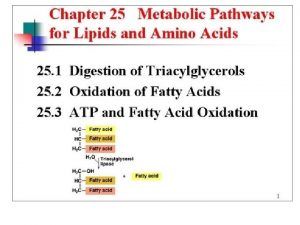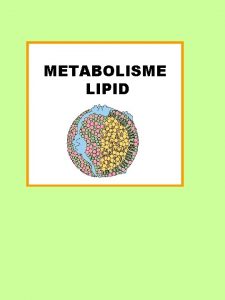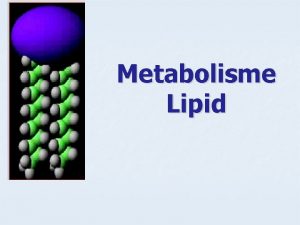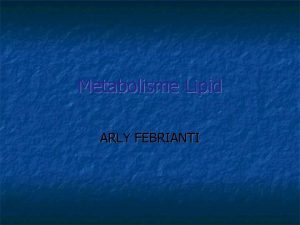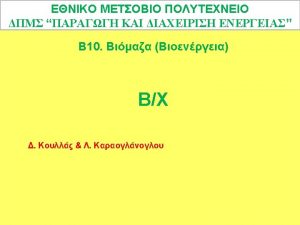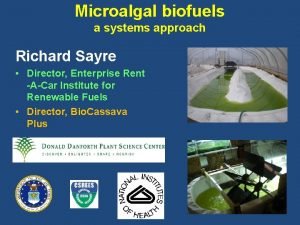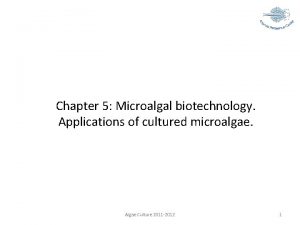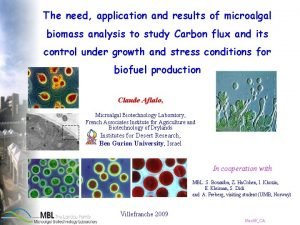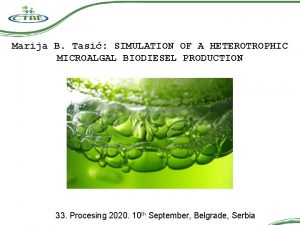Lipid Content of Various Microalgal Species found in














- Slides: 14

Lipid Content of Various Microalgal Species found in Lake Lanier Caitlin Mc. Mullan, Courtney Vaeth and Melba Horton http: //www. nutraingredients-usa. com/Suppliers 2/New-algae-omega-3 s-player. Qualitas-goes-head-to-head-with-krill

Significance Potential in biofuel production Help achieve 40% cut in CO 2 emissions by 2030 (Alternative Energy, 2009) Diminish environmental impact; pollution Unrest in oil exporting countries; “energy independence” (Littlefield, 2013)

Importance of Microalgae Biomass emits low quantity of methane and carbon dioxide than fossil fuels Algal growth helps eliminate atmospheric carbon dioxide Require less water than terrestrial crops Can be grown in non-arable land Fertilizers can be received from waste-waters Biomass can be manipulated by altering growth conditions (Gouveia & Oliveira, 2009)

http: //www. biodiesel-kits-online. com/algae-biodiesel. html

Objective To determine the lipid content of the different species of microalgae that are locally found in Lake Lanier waters Source: http: //peakwater. org/tag/lake-lanier/

Null Hypothesis There is no significant difference in the lipid content of the different species of microalgae that are locally found in Lake Lanier

Methodology Species of Algae Mixture of algae found in Lake Lanier waters: Anabaena, Chlamydomonas, Chlorella, Closterium, Euglena gracilis, Oedogonium foveolatum, Oscillatoria, Synedra, Volvox aureus Monoculture of Scenedesmus dimorphus Monoculture of Spirogyra (UTEX) Algal Cultivation Controlled Chamber 20°C Cool-white fluorescent bulbs; 3200 lux 12/12 h L/D periodicity Cells grown in 250 m. L flasks Proteose Medium: 1 L Bristol Medium 10 m. L Sodium Nitrate; 10 m. L Calcium Chloride; 10 m. L Magnesium Sulfate; 10 m. L Potassium Phosphate Monobasic; 10 m. L Sodium Chloride; Fill with d. H 2 O 1 g/L Proteose Peptone

Culture Change by Centrifugation Pour algae into 50 m. L tubes Make sure tubes are evenly distributed Set centrifuge to desired speed and time 1200 rpm for 2 minutes Voila! Algae pellets

Large Biomass for Extraction Modified the Dyer & Bligh (1959) model using solvents chloroform and methanol in a 2: 1 ratio (Zhu, & et. al. , 2002) 1 g microalgae: 3 m. L solvent mixture Allow biodiesel and sediment layers to settle Filter sample through filter paper Transfer sample to beaker http: //www. biorefinery. uga. edu/biomassdevelopment. htm l

Lipid Content Determination Portion of lipid extract was dried, and solvent evaporated by heated water bath at 40°C Lipid residue was dried Total lipid content = (weight of lipid in aliquot x volume of chloroform layer) / (volume of aliquot) (Bligh & Dyer, 1959)

Results Lipid Content (%) 70 60 50 40 30 20 10 0 Mixed Algae Spirogyra Scenedesmus

Implications Null hypothesis is rejected Highest lipid content from mixed algal species than monocultures of S. dimorphus and Spirogyra Algal species found in Lake Lanier has very good potential for biofuel production

Future Plans Repeat extractions to be able to determine statistical significance of results Investigate the effect of pressure gradient on the lipid production of algae from Lake Lanier

Literature Cited Alternative energy. (2009). Petroleum Economist, 22. Bligh, E. G. , & Dyer, W. J. (1959). A Rapid Method of Total Lipid Extraction and Purification. Canadian Journal of Biochemistry and Physiology. 37(8) doi: 10. 1139/o 59 -099 Gouveia, L. , & Oliveira, A. (2009). Microalgae as a Raw Material for Biofuels Production. Journal Of Industrial Microbiology & Biotechnology, 36(2), 269 -274. doi: 10. 1007/s 10295 -008 -0495 -6 Littlefield, S. (2013). Security, independence, and sustainability: Imprecise language and the manipulation of energy policy in the United States. Energy Policy Special Section: Transition Pathways to a Low Carbon Economy, 52, 779 -788. Retrieved November 1, 2014, from Science Direct. Mercer, P. , & Armenta, R. E. (2011). Developments in Oil Extraction from Microalgae [electronic resource]. European Journal Of Lipid Science And Technology, 113(5), 539 -547. Sharif Hossain, A. M. , Salleh, A. , Boyce, A. , Chowdhury, P. , & Naqiuddin, M. (2008). Biodiesel Fuel Production from Algae as Renewable Energy. American Journal Biochemistry & Biotechnology, 4(3), 250 -254. UTEX The Culture Collection of Algae. (n. d. ). UTEX The Culture Collection of Algae. Retrieved September 21, 2014, from http: //www. sbs. utexas. edu/utex/ culturemaintenance. aspx Visser, A. W. , & Jónasdottir, S. H. (1999). Lipids, Buoyancy and the Seasonal Vertical Migration of Calanus finmarchicus. Fisheries Oceanography, 8100 Zhu, M. , Zhou, P. , & Yu, L. (2002). Extraction of Lipids From Mortierella alpina and Enrichment of Arachidonic Acid from the Fungal Lipids. Bioresource Technology, 84(1), 93 -95. Of
 Lipid
Lipid Keystone species definition biology
Keystone species definition biology Carrier content and real content in esp
Carrier content and real content in esp Static content vs dynamic content
Static content vs dynamic content Peta konsep katabolisme pati
Peta konsep katabolisme pati Metabolisme lipid
Metabolisme lipid Triacylglycerols
Triacylglycerols Lipid
Lipid Prolactin target cells
Prolactin target cells Lipid
Lipid Monomer in lipids
Monomer in lipids Copper acetate test positive result
Copper acetate test positive result Alpha lipid colostrum new zealand
Alpha lipid colostrum new zealand Hdl ldl
Hdl ldl Lipid structure
Lipid structure
